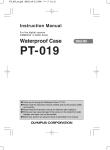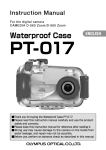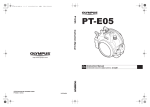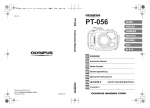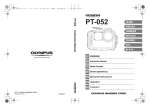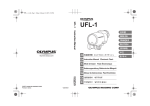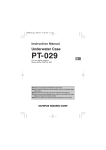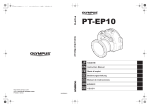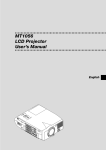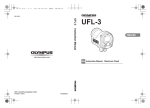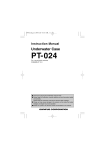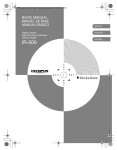Download Olympus SP-310/SP350 User's Manual
Transcript
Instruction Manual Underwater Case PT-030 For the digital camera SP-310/SP350 ■ Thank you for buying the Underwater Case PT-030. ■ Please read this instruction manual carefully and use the product safely and correctly. ■ Please keep this instruction manual for reference after reading it. ■ Wrong use may cause damage to the camera on the inside from water leakage, and repair may not be possible. ■ Before use, perform an advance check as described in this manual. Disclaimer ● Unauthorised copying of this manual in part or in full, except for private use, is prohibited. Unauthorised reproduction is strictly prohibited. ● OLYMPUS IMAGING CORP. shall not be responsible in any way for lost profits or any claims by third parties in case of any damage occurring from incorrect use of this product. ● OLYMPUS IMAGING CORP. shall not be responsible in any way for damage, lost profits, etc. caused by the loss of image data due to defects, disassembly, repair or modification of this product by people, other than third parties specifically authorised by OLYMPUS IMAGING CORP. or for other reasons. Please read the following before using the product ● This product has been precision-crafted from high quality polycarbonate. When used correctly, it lets you take photographs safely up to a water pressure equivalent to a depth of 40 metres. ● To ensure correct and safe use of the case, please read all instructions on handling and carrying out the system check as well as care, maintenance and storage of the case. ● OLYMPUS IMAGING CORP. shall in no way be responsible for damage caused by water to the camera contained in the case. ● OLYMPUS IMAGING CORP. shall not pay any compensation for accidents (injuries or material damage) that happen during the use of this product. ● Before use, be sure to read the precautions printed on the package. For safe use This instruction manual uses various pictographs for correct use of the product and to prevent danger to the user and other persons as well as property damage. These pictographs and their meanings are shown below. WARNING This indicates contents for which the possibility of human death or severe injury in case of handling under disregard of this indication can be assumed. CAUTION This indicates contents for which the possibility of human injury or the possibility of material damage in case of handling under disregard of this indication can be assumed. E-1 WARNING 1. Keep this product out of the reach of babies, infants, and children. There is the possibility of occurrence of the following types of accidents. Injury by dropping onto the body from a height. Injury from parts of the body getting caught in parts which open and close. Swallowing of small parts. Please consult a physician immediately if any parts have been swallowed. Triggering of the flash in front of the eyes may cause permanent vision impairment etc. 2. Do not store with a battery in the digital camera housed in this product. Storage with a battery inserted may lead to leakage of the battery liquid and fire. 3. If leakage of water should occur with a camera installed in this product, quickly remove the battery from the camera. There is the possibility of ignition and explosion from generation of hydrogen gas. 4. This product is made of resin. There is the possibility that injuries may be caused when it becomes broken because of strong impact with a rock or other hard objects. Please handle with sufficient care. 5. The silica gel and the grease for silicone O-rings for this product are not edible. CAUTION 1. Do not disassemble or modify this product. This may cause water leakage or trouble. In case of disassembly or modification by persons other than those appointed by OLYMPUS IMAGING CORP., the guarantee shall not apply. 2. Do not place this product at locations with abnormally high or abnormally low temperatures or at locations with extreme temperature changes. The product may deteriorate. 3. Opening and closing at locations with much sand, dust, or dirt may impair the waterproof characteristic and cause water leakage. This should be avoided. 4. This product has been designed and manufactured for use at a water depth within 40 m. Please note that diving to a depth in excess of 40 m may cause permanent deformation or damage to the Case and the camera inside the Case or may lead to water leakage. E-2 5. Rough handling, such as jumping into the water with the case in your hand or in an outside pocket or throwing the case into the water, etc. could lead to water leakage. Please always take care when using the case. 6. If the camera contained in the case becomes wet because of water leakage, etc., immediately wipe off all moisture and check the camera is working correctly. 7. Before travelling by air, please make sure you remove the O-ring, otherwise the difference in air pressure may make it impossible to open the case. 8. To ensure safe and trouble-free handling and operation of the digital camera in this product, please read the camera’s instruction manual carefully. 9. When sealing this product, please take care to ensure no foreign matter such as sand, dirt or hair are on the O-ring or contact surfaces. Batteries ● Although the camera can be powered with two “AA”-size batteries, it is recommended you use one CR-V3 battery. This will avoid the risk of battery power running out during underwater shooting. ● Make sure that the battery electrodes do not get wet. This may cause a malfunction or an accident. ● Refer to the camera instruction manual for additional cautions regarding batteries. Setting the camera mode ● The camera incorporates several shooting scene modes including wide-angle and macro modes. These simplify underwater shooting by enabling you to simply select the mode best suited to the scene you’re shooting. For details, refer to “Shooting with Scene Modes” on page E-27 of this manual. ● For information on setup, refer to the camera instruction manual. E-3 For Prevention of Water Leakage Accidents When water leakage occurs while this product is being used, repair of the camera housed in this product may become impossible. Please observe the following cautions for use. 1. When sealing this product, make sure that no hairs, fibers, sand particles or other foreign matter stick not only to the O-ring, but also to the contact surface. Even a single hair or a single grain of sand may cause water leakage. Please check with special care. Examples for foreign matter sticking to the O-ring Hair Fibers Grains of sand 2. The O-ring is a consumption product. Please replace it at least once a year by new one. Also perform maintenance for every use. 3. Deterioration of the O-ring will progress according to the use conditions and the storage conditions. Immediately replace the O-ring by a new one if it is damaged, shows cracks, or has lost its elasticity. 4. At the time of O-ring maintenance, clean the inside of the O-ring groove and confirm the absence of dirt, dust, sand, and other foreign matter. 5. Apply the specified silicone O-ring grease to the O-ring. 6. The waterproof function is not effective when the O-ring is not installed correctly. When installing the O-ring, take care that it does not project from the groove and that it is not twisted. Also, when sealing the Case, close the lid after confirming that the O-ring has not come out of the groove. 7. This product is an airtight construction made of plastic (polycarbonate). When it is left for a long time in a car, on a boat, at the beach, or at other places reaching a high temperature, or when it is subjected for a long time to uneven external force, it may be deformed and the waterproof function may be lost. Pay sufficient attention to temperature control. Also do not place heavy objects onto the product during storage or transport, and avoid unreasonable storage. 8. When the O-ring contact surface is pressed strongly from the E-4 outside of the Case, or when the Case is twisted, the waterproof function may be lost. Take care not to exert excessive force. 9. Please be sure to perform the advance test and the final test each time before using the case. 10. If you should notice drops of water or other signs of water leakage while taking pictures, immediately stop the dive, remove any water from the camera and the product, test according to the item "Final check", and confirm whether leakage has occurred or not. Handling the Product ● Use or storage of the product at the following locations may cause defective operation, defects, trouble, damage, fire, internal clouding, or water leakage. Always avoid these locations. Places where high temperatures exist, such as in direct sunlight, in a closed vehicle, etc., and/or where extreme differences in temperatures exist. Places where there is a lot of dust. Places where there are open fires. Places subject to vibrations. Places where volatile chemicals are stored or used. Water deeper than 40 meters. ● This product is made of polycarbonate resin with excellent impact resistance, but it may be damaged by scraping against rocks etc. It also may break when it hits hard objects or is dropped. ● This product is not a case to soften impacts to the camera inside the product. When this product with a digital camera inside it is subjected to impacts or heavy objects are placed onto it, the digital camera may become damaged. Please handle the product with sufficient care. ● When the product is not used for a long time, the waterproof performance may drop because of deterioration of the O-ring etc. Before use, always perform the advance test and the final check. ● Do not apply excessive force to the accessory mount, TTL cable connector or tripod socket. ● When a flash is used while the Case is being used, shadows may appear at the edges of the picture. This is especially notable when taking pictures in macro mode on the wide-angle side. Please use a flash after image confirmation. ● Do not use the following chemicals for cleaning, corrosion prevention, prevention of fogging, repair or other purposes. When these are used for the Case directly or indirectly (with the chemicals in vaporized state), they may cause cracking under high pressure or other problems. E-5 Chemicals which cannot be used Explanation Do not clean the Case with alcohol, gasoline, thinner Volatile organic solvents, or other volatile organic solvents or with chemical detergents etc. Pure water or lukewarm water is chemical detergents sufficient. Anticorrosion agent Do not use anticorrosion agents. The metallic parts are treated with plating or aluminum oxidation. Washing with pure water is sufficient. Commercial defogging agents Do not use commercial defogging agents. Always use the specified desiccant silica gel. Grease other than specified Use only the specified silicone grease for the silicone O-ring, as otherwise the O-ring surface may silicone grease deteriorate and water leakage may be caused. Do not use adhesive for repairs or other purposes. Adhesive When repair is required, please contact a dealer or a service station of our company. ● Do not perform operations other than specified in this instruction manual, do not remove or modify parts other than specified, and do not use parts other than specified. Any troubles in taking pictures or with the equipment resulting from the above actions shall be outside the guarantee. ● When the enclosure of the balance weight breaks, the metal on the inside may corrode. Take care not to damage the enclosure. ● After use, wash the balance weight with pure water and wipe off all moisture sufficiently. E-6 Contents Disclaimer ..................................................................................E-1 Please read the following before using the product ..................E-1 For safe use ..............................................................................E-1 Batteries ....................................................................................E-3 Setting the camera mode ..........................................................E-3 For Prevention of Water Leakage Accidents..............................E-4 Handling the Product..................................................................E-5 Contents ..............................................................................E-7-8 1. Preparations ......................................................................E-9 Check the contents of the package. ..........................................E-9 Names of the parts ..................................................................E-10 Install the strap. ...................................................................... E-11 Master the basic operation. .................................................... E-11 Holding the Case ..................................................................E-11 How to Press the Shutter ......................................................E-12 How to Use the Mode Dial ....................................................E-12 How to Use the Zoom Lever ................................................E-12 Setting the Zoom Lever ........................................................E-13 How to use the POWER Button ............................................E-13 Removing the TTL cable connector cap ..............................E-14 Removing the hot shoe cable cap ........................................E-15 Lubricating the TTL Connector Thread ................................E-15 2. Advance Check of the Case ......................................E-16 Advance test before use ..........................................................E-16 Making sure the case is waterproof ......................................E-16 Advance Test ........................................................................E-17 3. Install the digital camera. ..........................................E-18 Check the digital camera. ........................................................ E-18 Battery Confirmation ............................................................E-18 Confirmation of the Remaining Number of Pictures to be Taken........E-18 Remove the hand strap from the digital camera. ............................E-18 Prepare the camera ................................................................E-18 Which digital cameras can be loaded? ................................ E-18 Check the operation of the camera. .................................... E-18 Open the Case. ...................................................................... E-19 Insert the digital camera. ........................................................ E-19 Insertion of silica gel ............................................................E-20 Set the mode dial ..................................................................E-20 Check the loading status. ........................................................ E-21 E-7 Seal the Case...........................................................................E-21 Install the special balance weight.............................................E-21 Check the camera operation. ..................................................E-22 Installation and Removal of the LCD Hood ..............................E-23 Installation ............................................................................E-23 Removal ................................................................................E-23 Mounting and Removing the Lens Cap ....................................E-24 Perform the final checks. ........................................................ E-24 Visual inspection ..................................................................E-24 Final Test ................................................................................E-25 4. Taking Pictures Under Water ....................................E-26 How to Use the Hand Strap ....................................................E-26 Take pictures carefully. .......................................................... E-26 Confirm the picture on the LCD monitor. ..............................E-26 Quietly press the shutter lever. ............................................ E-26 Caution when using the flash ................................................E-26 5. Underwater Shooting According to the Scene Type ............E-27 Underwater shooting modes ....................................................E-27 Underwater Wide-Angle 1 ....................................................E-27 Underwater Wide-Angle 2 ....................................................E-27 Underwater Macro ................................................................E-27 Selecting the shooting scene mode. ...................................... E-28 6. Handling After Shooting ..............................................E-29 Wipe off any waterdrop. ..........................................................E-29 Removing the digital camera................................................... E-30 Wash the Case with pure water. ............................................ E-31 Dry the Case. .......................................................................... E-31 7. Maintaining the Waterproof Function ....................E-32 Remove the O-ring. ..................................................................E-32 Remove any sand, dirt, etc. .................................................... E-32 Install the O-ring. .................................................................... E-34 How to Apply Grease to the O-ring ..........................................E-34 Replace consumable products. .............................................. E-35 Maintenance of the threaded sections on the TTL cable and TTL cable connector ........................................E-35 Maintenance of the TTL Connector Cap ................................ E-36 8. Appendix ..........................................................................E-37 PT-030 Frequently Asked Questions ......................................E-37 Specifications ..........................................................................E-42 E-8 1. Preparations Check the contents of the package. Check that all accessories are in the box. Contact your dealer if accessories should be missing or damaged. LCD hood Silicone grease Silica gel (on the body) Waterproof cap for the TTL cable connector LCD hood strap Lenscap Waterproof cap maintenance adapter Hand strap Case body (Check that the O-ring is normal.) Balance weight O-ring remover PT-030 Instruction Manual Underwater Case For the digital camera SP-310 / SP-350 Authorised distributors list/ Authorised service centres list Mode d'emploi Caisson étanche Pour l'appareil photo numérique SP-310 / SP-350 Bedienungsanleitung Unterwassergehäuse Für die Digitalkamera SP-310 / SP-350 Manual de Instrucciones Caja estanca Para la cámara digital SP-310 / SP-350 SP-310 / SP-350 SP-310 / SP-350 Instruction manual (this manual) E-9 Names of the parts ❈ ❈ ❈ Palm grip Zoom lever Shutter lever Mode dial knob Accessory mount TTL cable connector Diffuser and diffuser cover Front lid Buckle hook Buckle lock lever Lens cap strap Lens cap Lens ring ❈ ❈ ❈ ❈ ❈ Lens window ❈ Hand strap ❈ Hand strap ring Shade hood Loading guide rails Tripod seat O-ring (POL-030) LCD inner hood LCD hood POWER button Flash mode button AEL button DISP/GUIDE button QUICK VIEW button OK/MENU button Cross-cursor buttons Rear lid LCD hood strap Grease for silicone O-ring (White cap) Silica gel Balance weight O-ring remover Waterproof cap maintenance adapter Note : The Case operation parts marked by ❈ corresponds to the operation parts of the digital camera. When the operation parts of the Case are operated, the corresponding functions of the digital camera will operate. For details of the functions, refer to the instruction manual for the digital camera. E-10 Install the strap. Install the strap on the Case body. Installation explanation Finished installation Hand strap Hand strap ring CAUTION : Please install the strap correctly as shown above. OLYMPUS IMAGING CORP. shall bear no responsibility for damage etc. caused by dropping the Case because of incorrect installation of the strap. Master the basic operation. Please master the basic operation of the Case before taking pictures. Holding the Case Hold the Case securely with both hands, keep your elbows close to your body, and hold the Case so that you can confirm the picture on the LCD monitor of the digital camera through the LCD monitor window of the Case. Good example Bad example CAUTION : • Do not exert excessive force onto the lens window or the lens ring. • Take care not to put your fingers etc. over the lens window and the flash diffuser. Note: • Check your image on the LCD monitor. The viewfinder cannot be used to check the image. E-11 How to Press the Shutter When pressing the shutter lever, press it gently, so that there will be no movement of the camera. Advice • For more detailed information on operating the shutter release, please consult the digital camera’s instruction manual. How to Use the Mode Dial The case is equipped with a mode dial knob that fits on the camera's mode dial and functions the same way. After inserting the digital camera into the case, make sure that the mode dial knob is operable before taking any image. Mode dial knob Advice • Please confirm that the mode dial knob has been set securely to the mode dial of the digital camera. If the mode of the digital camera does not change when the mode dial knob is operated, turn the dial while pushing it lightly. How to Use the Zoom Lever Zoom operation is possible by operating the zoom lever of this Case corresponding to the zoom lever of the digital camera in the Case. E-12 Setting the Zoom Lever When loading the digital camera in the Case, fit the projecting part of the zoom lever of the digital camera into the recessed part of the zoom lever on the inside of the Case. CAUTION : • When loading the camera, confirm that the projecting part of the zoom lever of the camera is properly set to the recessed part of the zoom lever of the Case. • When the setting is insufficient, the loading of the camera becomes imperfect and it may not be possible to seal the Case or zooming may not function. Insufficient sealing will cause water leakage. How to Use the POWER Button POWER button Press the POWER button to turn the camera ON/OFF. CAUTION : • When the digital camera is not used for about 3 minutes while in the shooting mode, it enters the sleep mode (standby status) and no operations are possible. To cancel sleep mode (and return to operation status), press the shutter button or any other button. For details, refer to your digital camera's instruction manual. E-13 Removing the TTL cable connector cap TTL cable connector cap 1 To perform TTL flash shooting in combination with the separately available Electronic Flash Case, remove the TTL cable connector cap as described below. 1Remove the TTL cable connector cap from the Case. 2Connect the Electronic Flash Case’s underwater TTL cable to the TTL connector on the Case. Remove. Turn counter clockwise. 2 Underwater TTL cable Use this mark to align the position. Insert into the connector. Turn the threaded section of the connector clockwise lightly until it is stopped. ---- How to attach the TTL cable connector cap to the case ---Make sure there is no foreign matter attached to the O-rings inside the cap and on the TTL cable connector. To secure the cap, gently turn it clockwise until it stops. Gently turn the cap clockwise until it stops. Put the cap on the case. CAUTION : • If the TTL cable connector cap is loose, water penetration may result. Be sure to gently turn the cap until it stops to make sure it is firmly secured. Do not turn or tighten the TTL cable too hard. If it is too tight, it may be difficult to loosen and remove it. ❈ For details on the TTL cable and hot shoe cable, refer to the instruction manual provided with the Electronic Flash Case. E-14 Removing the hot shoe cable cap To perform TTL flash shooting when this case is used, connect the hot shoe cable provided with the optional electronic flash case to the connector on this case and the camera’s hot shoe. 1 Turn the hot shoe cable connector cap inside the case counterclockwise to remove it. 2 Insert the connector of the hot shoe cable into the case's connector and turn the connector screws all the way clockwise to connect them firmly. 3 Insert the hot shoe on the hot shoe cable into the hot shoe on the camera. 4 When not using the hot shoe cable, attach the hot shoe cable cap to the hot shoe cable connector inside the case and turn the cap all the way clockwise to attach it firmly. CAUTION : • Be sure to remove the camera from the case when inserting the connector of the hot shoe cable into the case’s connector. Lubricating the TTL Connector Thread To facilitate attachment and removal of the TTL cable and TTL connector, apply the silicone O-ring grease (provided with this Case), to the threaded section. For details, see the maintenance description on page E-35 of this manual. CAUTION : • The SP-310 camera cannot be used in combination with the separately available electronic flash case. E-15 2. Advance Check of the Case Advance test before use This Case has been the subject of thorough quality control for the parts during the manufacturing process and thorough function inspections during the assembly. In addition, a water pressure test is performed with a water pressure tester for all products to confirm that the performance conforms to the specifications. However, depending on the carrying and storage conditions, the maintenance status, etc., the waterproof function may be damaged. Before diving, always perform the following advance test and the water leakage test after installation of the camera. Making sure the case is waterproof Check the parts that ensure the case is waterproof. 1. Make sure that the O-ring between the front and rear lids of the case is attached firmly and the buckle is tightly secured. 2. Make sure that the O-ring on the TTL cable connector cap is attached firmly and that the cap is fitted tightly to the connector. E-16 Advance Test 1. Before installing the digital camera in the Case, immerse the empty Case to the intended water depth to confirm that there is no water leakage. 2. Main causes of water leakage are as follows. The O-ring has not been installed. A part of the O-ring or the entire O-ring is outside the specified groove. O-ring damage, cracks, deterioration or deformation. Sand, fibers, hair or other foreign matter sticking to the O-ring, Oring groove or O-ring contact surface. Damage to the O-ring groove or O-ring contact surface. When closing the Case, check for catching of the hand strap and silica gel after the above causes have been eliminated. CAUTION : • The most suitable method for checking water leakage is to immerse the Case to the intended water depth. When this is difficult, water leakage also can be checked at a shallow depth with no water pressure. Do not feel that this is troublesome, but perform this test. • If the advance test should show water leakage with normal handling, stop using the Case and contact your dealer or an Olympus service station. E-17 3. Install the digital camera. Check the digital camera. Check the digital camera before loading it in the Case. Battery Confirmation Confirm that the remaining battery capacity is sufficient. Note: • To avoid missing shutter chances due the battery running out, you should always replace the battery with a fully charged battery before each dive. Confirmation of the Remaining Number of Pictures to be Taken Confirm that the image storage has a sufficient remaining number of pictures to be taken. Remove the hand strap from the digital camera. If a hand strap is attached to the digital camera, it must be removed. CAUTION : • If the digital camera is loaded without removing the strap, the strap may prevent the Case from closing properly, resulting in leakage. • When removing the strap, handle the digital camera carefully. OLYMPUS IMAGING CORP. is not responsible for any damage caused by dropping or otherwise mishandling the camera. Prepare the camera Which digital cameras can be loaded? This product (PT-030) is designed exclusively for use with the SP-310 and SP-350. Check the operation of the camera. Confirm the operation according to the instruction manual for the digital camera. E-18 Open the Case. Use the provided O-ring remover as described below. Insert the hook section below the buckle lock/unlock lever. Slowly pull the O-ring remover. If the O-ring remover is not available, push the buckle lock/unlock lever from the left and right with your thumb and index finger, and pull up the lever gently. Insert the digital camera. Make sure that the digital camera is turned OFF. Pull up the mode dial knob on the front lid of the Case and gently insert the digital camera into the Case, taking care that the projecting part of the camera’s zoom lever fits into the recessed part of the Case’s zoom lever section. Mode dial knob CAUTION : • Confirm that the projecting part of the zoom lever of the digital camera is set securely to the zoom lever notch on the inside of the Case. When the setting is not secure, the loading of the digital camera is not complete and closing of the rear lid of the Case may not be possible or zoom may not function even when the zoom lever is operated. • Insufficient sealing will cause water leakage. E-19 Insertion of silica gel Before sealing the Case, insert the accessory silica gel bag (for prevention of fogging) between the bottom of the camera and the Case. Insert the bag with the glued longer side to the inside. Pay attention to the orientation. CAUTION : • Insert the silica gel all the way at the specified location and with the specified orientation. When the orientation is not correct, the silica gel bag will be caught when the Case is sealed and water leakage will be caused. • Attempting to seal the Case with the bag inserted only part of the way will cause the silica gel bag to get caught by the O-ring and water leakage will occur. • Once silica gel has been used, the moisture absorption performance will be impaired. Always exchange the silica gel when the Case is opened and closed. Set the mode dial. After closing the rear lid of the Case, fit the Case’s mode dial (located on the front lid of the Case,) over the top of the digital camera’s mode dial. Mode dial knob Advice • After fitting the Case's mode dial knob, turn the knob to make sure that the camera's mode dial switches before closing the Case tightly. • If the camera’s mode dial does not turn when turning the mode dial knob, gently push in the knob while turning it. E-20 Check the loading status. Always perform the following final checks before sealing the Case. Has the digital camera been loaded so that the zoom lever operates properly? Has the silica gel been inserted all the way at the specified position? Are the O-ring and the O-ring contact surface free of dirt and other foreign matter? Is the O-ring installed properly both on the front and rear lids? Is the TTL cable connector cap attached securely? Seal the Case. When the rear lid is closed (quietly, so that the O-ring will not come out of the groove), the buckles are engaged with the edge of the rear lid, and the buckle lock levers are pushed down in arrow direction, the Case will be sealed airtight. CAUTION : • Seal the Case by turning both buckle lock levers down in arrow direction. When one of the buckles is left open, the Case will not be sealed and water leakage will be caused. Install the special balance weight. Install the special balance weight to the tripod mounting thread at the bottom of the Case. Install the balance weight securely by tightening the accessory screw of the balance weight. E-21 Check the camera operation. After sealing the Case, check that the camera functions normally. Push the POWER button on the Case and confirm that the camera turns ON/OFF. Turn the mode dial knob on the Case and confirm that the camera mode switches properly. Push the shutter lever on the Case and confirm that the camera shutter is released. Operate other control buttons on the Case and confirm that the camera functions as it should. POWER Zoom Mode Shutter CAUTION : • If the camera does not function properly, restart the digital camera installation procedure from “Check the digital camera.” on page E-18 of this manual. • Make sure that the mode dial can be moved after the camera has been loaded in the Case. If the mode dial does not move, there may be oil or grease on it; wipe it clean. • When the digital camera is not used for about 3 minutes while in the shooting mode, it enters the sleep mode (standby status) and no operations are possible. To cancel sleep mode and return to operation status, press the zoom lever, shutter button or any other button. For details, refer to the digital camera's instruction manual. E-22 Installation and Removal of the LCD Hood Installation Strongly push the mounting projections of the LCD hood as shown in the figure into the guides above and below the LCD monitor window. Removal Remove the mounting projections of the LCD hood from the guides above and below the LCD monitor window by widening the LCD hood. Guides Installation Removal E-23 Mounting and Removing the Lens Cap Fit the lens cap onto the lens ring as shown in the figure. Be sure to remove the lens cap before shooting. Perform the final checks. Visual inspection After sealing the Case, visually examine the sealed parts of the front and rear lids to make sure that the O-ring is not twisted or out of the groove and that no foreign matter is caught in the groove. CAUTION : • Hairs, fibers, and other narrow items are not very apparent, but they may cause entry of water, so that special attention is required. E-24 Final Test The final test after loading the camera is explained below. This is the only way to eliminate worry about possible entry of water! Always perform this test. It can be performed easily in a water tank or a bathtub. The required time is about five minutes. Simple water immersion test Explanatory image Hints As the Case is transparent, waterdrops entering into it can be confirmed easily. 1 Place the Case slowly into the water. 2 At first, immerse the Case for only three seconds. 3 Check that no water has entered into the Case. 4 Next, immerse the Case for 30 seconds. Check carefully for air bubbles! Do not perform any operation yet, but just observe. 5 Check that no water has entered. Remove the Case from the water and check that no water has accumulated at the bottom of the Case. Perform very careful confirmation. 6 Next, check by immersing for three minutes. 7 This is the final check. Has the silica gel become moist? 8 Now everything is all right. Do not forget the balance weight. In case of trouble with the O-ring, three seconds are enough for water to enter. Are there air bubbles coming out between the lids? Please check carefully. Remove the Case from the water and check that no water has accumulated at the bottom of the Case. Is there any water trickling down? Check carefully for air bubbles! Try operation of the buttons used frequently. Check carefully for air bubbles! If there is still no entry of water, everything is OK! This is very important! Has the silica gel become moist? Please check carefully! As the inside can be seen, the inspection for entry of water also can be made securely! Now everything is all right! Have a nice dive! Did you remember to attach the balance weight? E-25 4. Taking Pictures Under Water How to Use the Hand Strap Pass your hand through the accessory hand strap and adjust the length with the stop button. Take pictures carefully. Confirm the picture on the LCD monitor. This Case uses the LCD monitor to confirm the picture. Quietly press the shutter lever. When pressing the shutter lever, hold the Case securely with both hands and operate the lever quietly to prevent camera shake. Caution when using the flash When taking macro shots with a wide-angle setting, the flash may provide uneven and/or insufficient illumination. Flash working range Wide angle : Approx. 0.4 m to 3.8 m Tele : Approx. 0.4 m to 2.2 m Conditions at the time of shooting (clarity of the water, suspended matter, etc.), can affect the flash's working range. For this reason, the image should always be checked on the LCD monitor after capture. CAUTION : • When an underwater shooting lens is attached to the front of the lens ring on the Case, the light from the camera’s built-in flash will be obstructed. If you want to use a flash with such a lens, use an external flash. You can purchase an electronic flash and electronic flash case. E-26 5. Underwater Shooting According to the Scene Type To facilitate underwater shooting, the SP-310/SP-350 camera features a variety of preset configurations optimized for various underwater shooting situations. Underwater shooting modes (Examples) Underwater Wide-Angle 1 Suitable for shooting a scene that extends across a wide range such as a school of fish swimming through the water. Background blues are vividly reproduced. Underwater Wide-Angle 2 Suitable for shooting a large, slowly moving subject such as a dolphin or manta. In many dolphin-watching locations, use of a flash is not permitted to avoid frightening the dolphins. Although this mode was originally designed to work without the flash, it can also be enabled if required, for example when shooting a manta. Underwater Macro Suitable for close-up shooting of small fish and other underwater creatures. Natural colors underwater are accurately reproduced. Red tones can be enhanced by using the flash. E-27 Selecting the shooting scene mode To use one of the preset underwater shooting scene modes, turn the Case’s mode dial knob to set the camera mode to [SCENE]. While observing the LCD monitor screen, press the Up or Down cross-cursor button on the Case to select the optimum underwater shooting scene mode. Press the ON/MENU button to enter the selected underwater shooting scene mode. E-28 6. Handling After Shooting Wipe off any waterdrop. After completing the shooting and returning to land, wipe off any waterdrop sticking to the Case. Use air or a soft cloth not leaving any fibers to thoroughly wipe any waterdrop etc. from the joint between the front and rear lid, the shutter lever, the palm grips, and the buckles. CAUTION : • Especially when waterdrops remain between the front and the rear lid, they may spill to the inside when the Case is opened. Take special care to wipe off all waterdrops. • When opening the Case, take sufficient care that no water will drop from your hair or body onto the Case and the camera. • Before opening the Case, make sure that your hands or gloves are free of sand, fibers, etc. • Do not open or close the Case at locations where water or sand is to be sprayed. When this cannot be avoided because you have to exchange the battery or the image storage, place a sheet downwind from some object and take care that no water or sand is sprayed. • Take care not to touch the digital camera or the battery with hands wet with sea water. Note: • Moisten a towel etc. in advance with pure water and keep it in a plastic bag, so that you can wipe the salt from your hands and fingers before handling the camera. E-29 Removing the digital camera. Unlock the buckle on the Case and open its rear lid carefully. Pull up the Case’s mode dial knob and remove the digital camera from the Case, taking care that the bottom of the Case’s mode dial knob is not caught on the camera’s mode dial. CAUTION : • Always place the opened Case with the O-ring side facing up. When the Case is placed with the O-ring side facing down, dirt or other foreign matter may attach to the O-ring or the O-ring contact surface. This could result in leakage during the next dive. • Please refer top the digital camera’s operation manual for instructions on how to store pictures, transfer pictures, etc. E-30 Wash the Case with pure water. After use, seal the Case again after taking out the camera and wash it sufficiently in pure water as soon as possible. After use in sea water, it is effective to immerse it for a fixed time in pure water to remove any salt. CAUTION : • Water leakage may be caused when a high water pressure is applied locally. Before washing the Case with water, remove the digital camera from it. • Operate the shutter lever and various buttons of this product in pure water to remove salt adhering to the shaft. Do not disassemble for cleaning. • Drying the Case with adhering salt may impair the function. Always wash off any salt after use. Dry the Case. After washing with pure water, use a soft cloth without any salt on it and not causing any fibers to wipe off any waterdrop and dry the Case completely at a well ventilated location in the shade. CAUTION : • Do not use hot air from a hair drier or the like for drying and do not expose the Case to direct sunlight, as this may accelerate deterioration and deformation of the Case and deterioration of the O-ring, leading to leakage of water. When wiping the Case, take care not to cause scratches. E-31 7. Maintaining the Waterproof Function Remove the O-ring. Open the Case and remove the O-ring from the Case. Removal of the O-ring Insert the O-ring remover between the O-ring and the O-ring groove. Pass the tip of the inserted O-ring remover below the O-ring. (Be careful not to scratch the O-ring groove with the tip of the O-ring remover.) Hold the O-ring with your fingertips after it has come out of the groove and remove it from the Case. Remove any sand, dirt, etc. After visually checking that dirt has been removed from the O-ring, checking for attached sand and other foreign matter, as well as for damage and cracks can be done by squeezing the entire circumference of the O-ring lightly with your fingertips. E-32 Remove any foreign matter attached to the O-ring groove using a lintfree clean cloth or cotton swab. Also remove any sand or dirt attached to the O-ring contact surface on the front lid of the case. CAUTION : • When a mechanical pencil or a similar other sharp object is used to remove the O-ring or to clean the inside of the O-ring groove, the Case and the O-ring may be damaged and water leakage may be caused. • When the O-ring is checked with the fingertips, take care not to stretch the O-ring. • Never use alcohol, thinner, benzene or similar solvents or chemical detergents to clean the O-ring. When such chemicals are used, it is to be feared that the O-ring will be damaged or that its deterioration will be accelerated. E-33 Install the O-ring. Confirm that no foreign matter is attached, apply a thin coat of the accessory grease to the O-ring, and fit the O-ring into the groove. At this time, confirm that the O-ring does not stick out from the groove. How to Apply Grease to the O-ring 1 Apply the exclusive lubricant to each O-ring. Make sure that your fingers and the Oring are free of dirt, and squeeze about 5 mm of lubricant onto a finger. (5 mm is the most appropriate amount.) 2 Spread the lubricant all over the O-ring. Surround the lubricant with three fingers and spread it over the ring. Be careful not to use excessive force as this may stretch the O-ring. 3 Check that the O-ring is free of scratch or unevenness. After spreading the lubricant, check visually and by touch that the O-ring is not scratched and that its surface is flat. If it is damaged in any way, replace it with a brand-new O-ring. 4 Apply lubricant on the O-ring contact surface. Use the lubricant remaining on the fingers to clean and lubricate the case's contact surface. CAUTION : • Always perform maintenance of the waterproof function even when the Case has been opened to exchange the battery or the image storage during shooting. Neglecting this maintenance may become the cause of water leakage. • When the Case is not to be used for a long time, remove the O-ring from the groove to prevent deformation of the O-ring, apply a thin coat of silicone grease, and store it in a clean plastic bag or the like. • When drying is done with salt attached, it is likely that a function impairment will be caused. After use, always wash off any salt. E-34 Replace consumable products. The O-ring is a consumable product. Independent of the number of times the Case is used, it is recommended that the O-ring should be replaced by a new one at least once a year. Deterioration of the O-ring is accelerated by the use conditions and the storage conditions. Replace the O-ring even before a year has passed if it shows signs of damage, cracking or loss of elasticity. Note: • Please use original Olympus products for the silicone O-ring grease, the silica gel, and the O-ring. These consumable products also can be purchased at an Olympus service station. Maintenance of the threaded sections on the TTL cable and TTL cable connector If the threaded sections used to connect the TTL cable to the TTL cable connector are not maintained properly, salt and other seawater residue may adhere the TTL cable and prevent it from being disconnected. After use in seawater, clean off any salt, sand, or other residue as soon as possible, then dry the equipment thoroughly. Clean the threaded sections with a cotton swab and apply a thin, uniform layer of O-ring silicon grease (provided with this case). Clean and apply O-ring silicon grease to these sections. E-35 Maintenance of the TTL Connector Cap After removing the TTL connector cap from the waterproof cap, be sure to clean and grease the O-ring. Use the waterproof cap maintenance adapter to remove the O-ring unit from the waterproof cap. Waterproof cap Waterproof cap maintenance adapter 1 Insert the adapter by aligning its pin with the hole on the cap. 2 Turn the adapter counterclockwise to remove the O-ring unit. 3 After removing the O-ring attached to the O-ring unit, clean the O-ring groove and apply silicon grease to the O-ring. Then, re-attach the O-ring to the O-ring unit. O-ring ❈ Reverse the removal procedure to re-attach the O-ring unit to the waterproof cap. E-36 8. Appendix PT-030 Frequently Asked Questions Q1 : Which digital cameras can be used with the PT-030? A1 : The PT-030 is designed specifically for use with the model SP-310 or SP-350. Q2 : What precautions must be observed when loading the digital camera into the Case? A2 : Pay special attention to the following items when loading the camera into the Case. (1) Check that the remaining capacity of the battery in the digital camera is sufficient. (2) Check how many more pictures can be saved in image storage. Please use a storage medium with a sufficient space in order to reduce the number of times the Case has to be opened and closed. (3) Remove the strap from the digital camera. When the camera is loaded without removing the strap, the strap may get caught when the Case is sealed and this will cause water leakage. (4) Before sealing the Case, confirm that the O-ring has been installed properly. (5) Confirm that the TTL connector cap is closed tightly. (6) Confirm that the O-ring and the O-ring contact surface are free of dirt, hair and other foreign matter. (7) Insert the silica gel for defogging. Please use silica gel for the Olympus Case. (8) Be sure to pull up the mode dial knob of the Case before loading the camera in it. After inserting the camera, pushdown the mode dial knob to fit it on the camera’s mode dial. (9) Be sure to attach the special balance weight to the tripod seat after completing installation. Q3 : What cautions must be observed when using and storing the Case? A3 : Pay special attention to the following items. (1) When the O-ring contact surface is pressed strongly from the outside of the Case, or when the Case is twisted, the waterproof function may be impaired and water leakage may be caused. (2) When the Case is used, left or stored at the following locations, defective operation or trouble may be caused. Always avoid such locations. (a) Places where the Case can reach high temperatures under direct sunlight or in a car, places with extremely low temperatures, and places with extreme temperature variations E-37 (b) Places with open fire (c) Places with volatile substances (d) Places with vibrations (3) In case of the following handling with a camera loaded into the Case, trouble or breakage may be caused for the Case and/or the loaded camera. Always avoid such handling. (a) Hitting other objects (b) Dropping (c) Placing heavy objects on top of the Case (4) When the Case is not used for a long time, trouble from formation of mold etc. may be caused. Before use, confirm the operation of all operation parts and perform the advance test and the final test. Q4 : What cautions must be observed when opening and closing the Case? A4 : Pay special attention to the following items. (1) Do not open and close the Case at locations with water spray or sand spray. (2) Wipe off all waterdrops from the gap between the front lid and the rear lid and around projections and recesses such as the buckles. When this is not done, entry of waterdrops into the Case is to be feared at the time of opening and closing. (3) When opening the Case, take care that no water will drip from your hair or body into the Case or onto the camera. (4) When the Case is open, confirm that the O-ring and the O-ring contact surface on the front lid are free of sand, fibers or other foreign matter. (5) Do not touch the camera or the image storage with your hands to which sea water is sticking. (6) If you should detect waterdrops or other signs of water leakage while shooting, immediately end the dive, perform the water leakage test again, and confirm that there is no leakage. If the camera is wet, wipe off any moisture and check the operation. Q5 : How should the Case be handled after use? A5 : After use, take out the camera as soon as possible and wash the Case with pure water. In case of use in the ocean, it is effective to immerse the Case for a certain time in pure water to remove any salt. Operate the buttons and levers under water to turn the shafts and wash off any salt. After washing, use a dry cloth without any salt on it to wipe off any moisture and dry the Case in the shade. Do not use hot air from a hair drier or the like and do not dry the Case under direct sunlight. Exposure to high temperatures or direct sunlight may cause deformation, discoloration or breakage of the Case and deterioration of the O-ring. Wipe the inside of the Case with a soft cloth not causing any fibers. E-38 Remove the O-ring, wipe off any salt, sand, dust, etc., and also clean the O-ring groove and the O-ring contact surface in the same way and then dry them. When an object with a sharp tip is used to remove the O-ring from the groove, the O-ring may be damaged and water leakage may be caused. Always use the provided O-ring remover. Q6 : How should I take pictures under water? A6 : Please observe the following items for shooting under water. (1) Fix the Case with the accessory hand strap to your wrist. (2) When you place a finger onto the lens window, the finger will appear in the photo. Pay attention to the position of your fingers when holding the Case. (3) When pressing the shutter lever, hold the Case securely with both hands and operate the lever quietly to prevent camera shake. (4) Before shooting, look through the LCD monitor window on the rear of the Case to confirm that a picture is displayed on the camera’s LCD monitor. In order to avoid missing shutter chances due to an exhausted battery, you should always replace the battery with a fully charged battery before each dive. Q7 : How can I check for water leakage? A7 : For confirmation, perform the advance test and the final test after loading the camera. The advance test with immersing the Case without the camera to the intended use depth to check for water leakage is the most accurate test, but when this is difficult, it is safer to perform this test even at a depth of 1 m or in a bathtub. The final test also can be performed in a bathtub or a bucket. Q8 : What are the causes for entry of water? A8 : The main causes for the entry of water are shown below. Please check them most carefully. (1) Forgetting to install the O-ring (2) The O-ring is partly or completely outside the groove. (3) Damage, deterioration, or deformation of the O-ring (4) Sand, fibers, hair or other foreign matter on the O-ring (5) When foreign matter (sand, fiber, hair, etc.) is stuck to the O-ring grooves or O-ring contact surfaces. (6) Catching of the strap, the bag of silica gel, etc. at the time of sealing the Case. (7) Throwing the Case from a boat into the water, jumping with the Case into the water, or other sudden application of strong forces onto the Case. When entering the water, hand the Case over quietly or avoid impacts in other ways. Q9 : What are the important points for O-ring maintenance? E-39 A9 : Please observe the following items. (1) Never use alcohol, thinner, benzene or similar organic solvents or chemical detergents to clean the O-ring. When such chemicals are used, it is to be feared that the O-ring will be damaged or that its deterioration will be accelerated. (2) Use the original Olympus silicone O-ring grease (white cap). The grease attached to Cases up to PT-008 (red cap) and the grease of other companies are not suitable for this silicone O-ring, and use of such grease may cause deterioration of the surface and impairment of the waterproof function. (3) In order to avoid deformation of the O-ring when the Case is not used for a long time, remove the O-ring from the Case, apply a thin coat of the special grease, and store the O-ring in a clean plastic bag. For reuse, confirm that the O-ring is free of damage and cracks, that it has sufficient elasticity, that the surface is free of stickiness and other abnormalities, and use it after applying a thin coat of the special grease. Excessive application of grease does not improve the waterproof function or the permissible withstand pressure. However, it may facilitate attachment of sand, dirt, etc. A thin, uniform coat produces the best result. (4) The O-ring is a consumable product. Replace it at least once a year. (5) Deterioration of the O-ring is accelerated by the use conditions and the storage conditions. Replace the O-ring immediately by a new one if it shows signs of damage, cracking or loss of elasticity. Q10: What are the important points for Case maintenance? A10: Please observe the following items. (1) Never use the following chemicals for cleaning, corrosion protection, defogging, repair or other purposes. • Never use alcohol, thinner, benzene or similar volatile organic solvents or chemical detergents to clean the Case. Pure water or lukewarm water is sufficient for cleaning. • Do not use anticorrosion agents on the metal parts. The metal parts are made of aluminum, brass or stainless steel. Cleaning with pure water is sufficient. • Do not use commercial defogging agents. Always use the original Olympus defogging silica gel. • Do not use adhesive for repairs or other purposes. When repair is required, please contact a service station of our company or your dealer. Q11: Please tell me about repairs. A11: Please contact a service station of our company or your dealer, if repair E-40 should be necessary. Do not try to repair, disassemble or modify the Case yourself. Repair, disassembly or modification by you or third parties not authorized by Olympus invalidates the guarantee. Q12: What are the model numbers and the prices of the PT-030 accessories? A12: The following accessories are available. (1) O-ring for the PT-030 body (POL-030): This is a silicone rubber O-ring packing to be installed in the PT-030 body to make it waterproof. O-rings for other Case models cannot be used. (2) Silicone O-ring grease (PSOLG-1): This is special grease for silicone Oring maintenance. (3) Silica gel (SILCA-5): This is a desiccant used to prevent fogging of the glass parts of the Case. The quantity is five bags. (4) LCD hood (PFUD-05): This hood is installed on the LCD monitor window of the Case to make it easier to see the LCD monitor of the camera. (5) Balance weight for PT-030 (PWT-030): This renders the weight of the Case under water close to the neutral buoyancy. It is environmentfriendly and does not contain lead. ❈ You can order in large computer shops and camera mass sale stores. ❈ Please contact your dealer or a service station of our company when replacement is required. Replacement will be made against payment. E-41 Specifications Available models Olympus digital cameras SP-310/SP-350 Pressure resistance Depth of up to 40 m Main materials Main body: Transparent polycarbonate Buckles: Stainless steel Grip/shutter release lever/zoom lever/mode dial knob: Red polycarbonate Lens window: FL reinforced glass Lens ring/TTL cable connector cap: Aluminum Operation buttons/Waterproof cap maintenance adapter: Nickel-plated brass O-rings/lens cap: Silicone rubber LCD hood: NBR rubber Dimensions Width 133 mm x height 93.5 mm x thickness 68.5 mm (projections not included) Weight 316 g (LCD hood not included) ❈ We reserve the right to change the external appearance and the specifications without notice. E-42 http://www.olympus.com/ Shinjuku Monolith, 3-1 Nishi-Shinjuku 2-chome, Shinjuku-ku, Tokyo, Japan Two Corporate Center Drive, P.O. Box 9058, Melville, NY 11747-9058, U.S.A. Tel. 631-844-5000 Technical Support (USA) 24/7 online automated help: http://www.olympusamerica.com/support Phone customer support: Tel. 1-888-553-4448 (Toll-free) Our phone customer support is available from 8 am to 10 pm (Monday to Friday) ET E-Mail: [email protected] Olympus software updates can be obtained at: http://www.olympus.com/digital Premises: Wendenstrasse 14-18, 20097 Hamburg, Germany Tel: +49 40-23 77 3-0 / Fax: +49 40-23 07 61 Goods delivery: Bredowstrasse 20, 22113 Hamburg, Germany Letters: Postfach 10 49 08, 20034 Hamburg, Germany European Technical Customer Support: Please visit our homepage http://www.olympus-europa.com or call our TOLL FREE NUMBER* : 00800 - 67 10 83 00 for Austria, Belgium, Denmark, Finland, France, Germany, Italy, Luxemburg, Netherlands, Norway, Portugal, Spain, Sweden, Switzerland, United Kingdom * Please note some (mobile) phone services/provider do not permit access or request an additional prefix to +800 numbers. For all not listed European Countries and in case that you can’t get connected to the above mentioned number please make use of the following CHARGED NUMBERS: +49 180 5 - 67 10 83 or +49 40 - 237 73 899 Our Technical Customer Support is available from 9 am to 6 pm MET (Monday to Friday) ¤2005














































